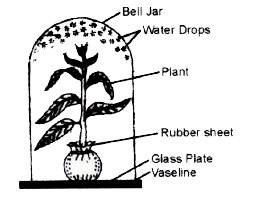[A]: Incompatibility is a gene physiological process.
[R]: Moderately high temperatures are also known to reduce self incompatibility reaction in certain plants.
If both A and R are true and R is the correct explanation of A
If both A and R are true but R is not the correct explanation of A
If A is true and R is false
If both A and R are false
The correct Answer is:B
To analyze the assertion and reason provided in the question, we will break it down step by step.
Step 1: Understand the Assertion
The assertion states that "Incompatibility is a gene physiological process."
- Explanation: Incompatibility refers to the inability of certain plants to fertilize themselves or to accept pollen from certain other plants. This is often due to genetic factors that affect the reproductive process. Therefore, the assertion is true.
Step 2: Understand the Reason
The reason states that "Moderately high temperatures are also known to reduce self-incompatibility reactions in certain plants."
- Explanation: It is known that environmental factors, including temperature, can influence the physiological processes in plants. Specifically, moderately high temperatures can indeed reduce the self-incompatibility reactions, allowing for fertilization that would otherwise not occur. Thus, this reason is also true.
Step 3: Analyze the Relationship Between Assertion and Reason
Now we need to determine if the reason correctly explains the assertion.
- Explanation: While both the assertion and the reason are true, the reason does not explain why incompatibility is a gene physiological process. The assertion is about the genetic basis of incompatibility, while the reason discusses the effect of temperature on the self-incompatibility reaction. They are related but do not directly explain one another.
Conclusion
Both the assertion (A) and the reason (R) are true, but the reason is not a correct explanation of the assertion. Therefore, the correct answer is that both A and R are true, but R is not the correct explanation of A.
Final Answer
Both A and R are true, but R is not the correct explanation of A.
---
The assertion states that "Incompatibility is a gene physiological process."
- Explanation: Incompatibility refers to the inability of certain plants to fertilize themselves or to accept pollen from certain other plants. This is often due to genetic factors that affect the reproductive process. Therefore, the assertion is true.
The reason states that "Moderately high temperatures are also known to reduce self-incompatibility reactions in certain plants."
- Explanation: It is known that environmental factors, including temperature, can influence the physiological processes in plants. Specifically, moderately high temperatures can indeed reduce the self-incompatibility reactions, allowing for fertilization that would otherwise not occur. Thus, this reason is also true.
Now we need to determine if the reason correctly explains the assertion.
- Explanation: While both the assertion and the reason are true, the reason does not explain why incompatibility is a gene physiological process. The assertion is about the genetic basis of incompatibility, while the reason discusses the effect of temperature on the self-incompatibility reaction. They are related but do not directly explain one another.
Both the assertion (A) and the reason (R) are true, but the reason is not a correct explanation of the assertion. Therefore, the correct answer is that both A and R are true, but R is not the correct explanation of A.
Both A and R are true, but R is not the correct explanation of A.
Topper's Solved these Questions
Similar Questions
Knowledge Check
Assertion : Self-incompatibility is a genetic mechanism which prevents self-pollination and thereby fertilisation by inhibiting either pollen germination or pollen tube growth in the pistil.
Reason : In gametophytic self-incompatibility, the incompatibility reaction is determined by the genotype of the sporophytic tissue of the plant from which the pollen is derived.AIf both assertion and reason are true and reason is the correct explanation of assertionBIf both assertion and reason are true but reason is not the correct explanation of assertionCIf assertion is true but reason is falseDIf both assertion and reason are false
Chemicals which provide physiological adaptations to plants against high temperature and saline conditions are
View SolutionDefine self-incompatibility. How do self-incompatible plants pollinate?
View SolutionName the type of pollination in self-incompatible plants.
View SolutionRead the following paragraph and answer the questions given below ,
Stable equilibrium is of various types . Mechanical equilibrium is achieved when all particles are at rest and total potential energy of the system is minimum . At any stage where particles are at rest but the system is not at stable equilibrium as it can reduce its potential energy by reverting to another position, is called metastable equilibrium . Thermal equilibrium is result from the absence of temperature gradients in the system. Chemical equilibrium is obtained when no further reaction occurs between reacting substances, i.e forward and reverse rates of reaction are equal.
When steam with solid iron at high temperature Fe3O4(s) and hydrogen gas are produced . But the reaction never goes to completion. This is because as the products are formed the reaction proceeds in reverse direction and when rate of reverse reaction is equal to rate of forward reaction , the concentration of reactants and products become constant and equilibrium is reached.
The primary objective of the passage is
View SolutionGiven below is an apparatus which was setup to investigate a physiological process in plants. The setup was placed in bright sunlight. Answer the questions that follow:

List two adaptations in plants to reduce the above process.
View SolutionSelf-incompatibility in plants is an adaptation which promotes cross pollination. How?
View SolutionThe molar heat capacity , Cv of helium gas is 3/2R and is independent of temperature. For hydrogen gas, Cv approaches 3/2R at very low temperature, equal 5/2R at moderate temperature and is higher than 5/2R at high temperatures. Give a reason for the temperature dependence of Cv in case of hydrogen, in not more than two or three sentences.
View Solution
